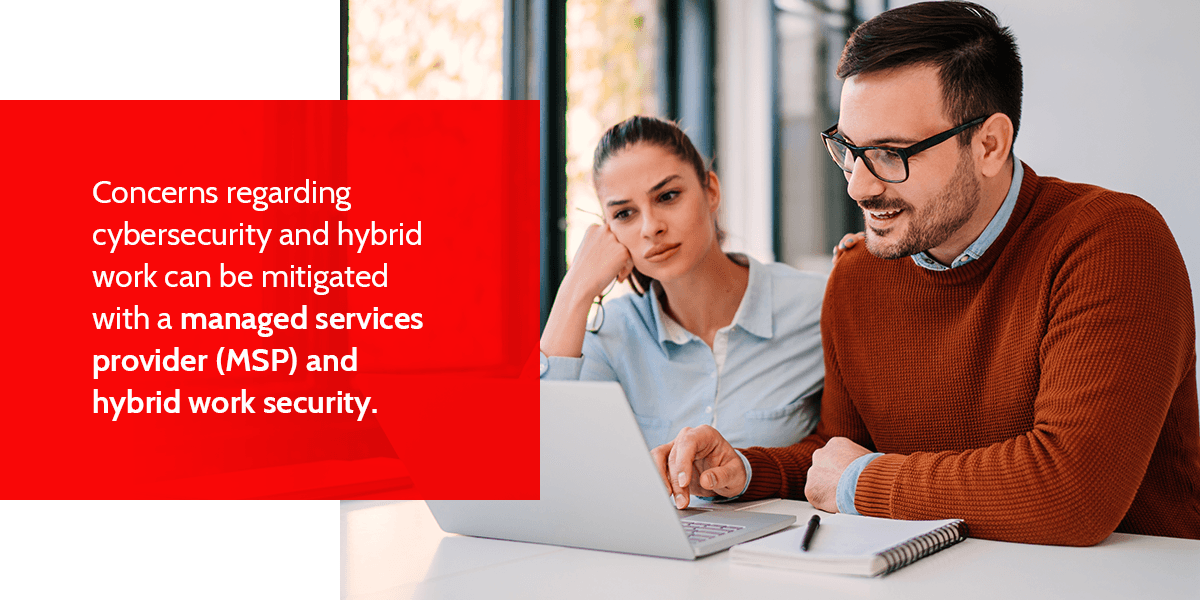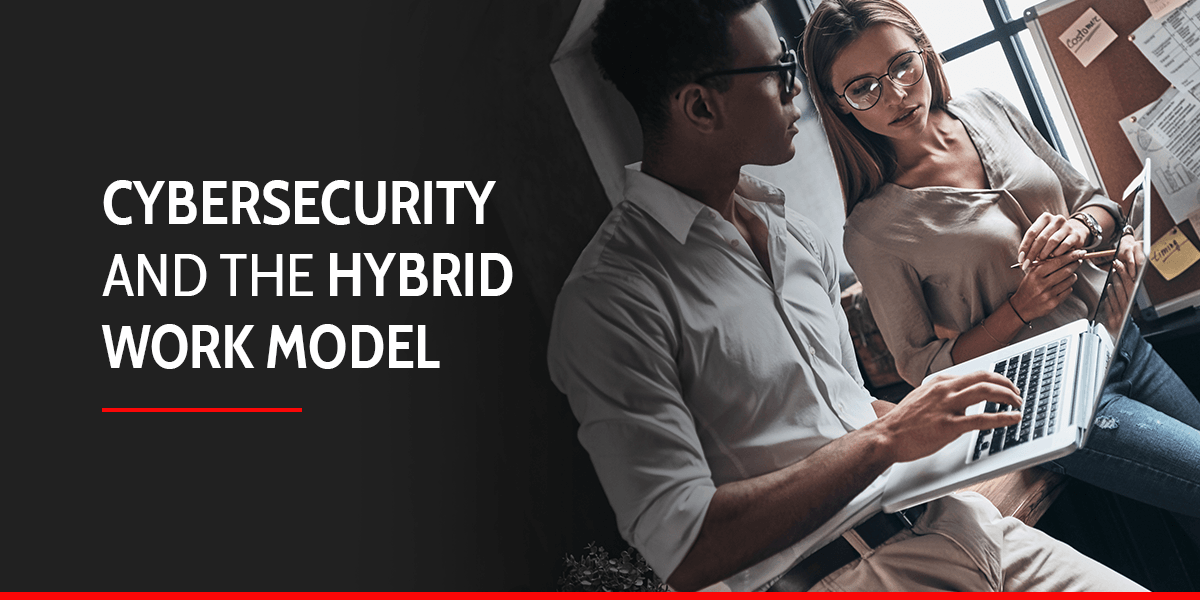- How the Hybrid Work Model Works
- 4 Cybersecurity Concerns For a Hybrid Workforce
- How MSPs Can Provide Hybrid Workforce Security
As organizations shift the way they operate in the wake of the pandemic, a hybrid work model is on the rise. Hybrid work presents some new cybersecurity challenges to employers and employees, such as employees taking work laptops home and connecting home devices to corporate VPNs. Facing these challenges, many businesses need the tools to both support employees working remotely and maintain their cybersecurity.
More companies are moving toward a return to the office and a hybrid work model. If an organization fails to maintain security best practices within their new work model, they put their reputation, data and employees’ privacy at risk. At Focus Technology, we offer cybersecurity services to keep your organization and hybrid workplace technology secure.
How the Hybrid Work Model Works
While remote work involves performing all work via remote access, hybrid work involves working in a mixed environment, such as commuting to the office a few days a week and working remotely the rest of the week. The hybrid work model is quickly becoming the new normal, and this trend will likely continue in the coming years.
There are a few types of hybrid work models to consider for your workplace, including:
- Office-first hybrid work model: In the office-first hybrid work model, employees can choose to work in the office or work remotely, but employees have to be more present at the office. If your company’s productivity relies on collaboration, you may want to choose the office-first hybrid work model. This hybrid work model enables flexibility and encourages collaboration, but may not be the most practical for some companies.
- Remote-first or at-will hybrid work model: With this hybrid work model, employees prioritize remote work or can perform on-site work if they prefer. For employees who want to work at the office, physical workspaces remain available. This model allows employees to choose the work environment they prefer. The remote-first hybrid work model can improve efficiency, increase productivity and cater to all employees, but it can also be unpredictable and lead to overcrowding or underutilized space.
- Week-by-week hybrid work model: If you choose the week-by-week hybrid work model, you will assign alternating on-site work weeks to different teams. With this model, your organization can dramatically reduce overhead costs and the necessary office space for your operations. Disadvantages include the lack of flexibility, which may cause problems. However, this work model can be implemented gradually and may work well for large companies.
- Split-week hybrid work model: This model assigns specific days for remote work and on-site work. One department can work out of the office during the first part of the week while other teams work remotely, for example. This model ensures your office doesn’t become overcrowded and each team or department has the opportunity to work collaboratively every week. This type of hybrid work model, however, can increase on-site expenses.
4 Cybersecurity Concerns For a Hybrid Workforce
While working remotely, employees could accidentally put your organization’s security and data at risk. Remote work can lead to various cybersecurity vulnerabilities, such as identity fraud and data breaches.
1. Weak Passwords
Businesses that use cybersecurity software like firewalls and VPNs to protect the remote network may still be at risk if employees use weak or repeat passwords for their accounts. Human error is easier for hackers to exploit than sophisticated cybersecurity software, so hackers will attempt to hack accounts by cracking the passwords, giving them access to your organization’s sensitive information.
2. Insecure Home Internet for Online Work
Even if your organization secures your employees’ work laptops, home Wi-Fi networks can pose a risk to your company’s cybersecurity. Though your employees may update their antivirus or smartphone software, they may overlook updates to their home router software. Without the right updates, routers will lack the most recent security patches, which can put your company at risk of data breaches.
3. Phishing Schemes
Employees can unknowingly give cybercriminals and hackers access to your organization’s sensitive data and network. Phishing schemes are a major cybersecurity threat to employees working remotely. During these schemes, a person or entity typically poses as a legitimate source over email with the intention to trick the victim into providing sensitive information or personal login credentials. With this information, the attacker can carry out identity fraud, hack accounts and steal additional sensitive information.
4. Personal Devices Used for Work Tasks
If employees don’t bring home their work devices, they may use personal devices like home printers, laptops and smartphones to work remotely. Though using personal devices can give employees a sense of flexibility, they can also pose cybersecurity risks to your organization. Many workers don’t encrypt their personal devices, so conducting work on a personal phone or laptop can put data at risk. Similarly, even printers can pose a security risk to your company, as they have multiple features that can have security gaps.

How MSPs Can Provide Hybrid Workforce Security
Concerns regarding cybersecurity and hybrid work can be mitigated with a managed services provider (MSP) and hybrid work security. An MSP can offer guidance to improve your business’s security protocols, such as:
- Implement password policies: To avoid weak or repeated passwords, your organization can implement password policies. Ban the use of repeat passwords and personal information and encourage or mandate the use of passphrases instead, which are a group of random words. Longer passwords are harder for hackers to crack, so encourage passphrases that include several words, punctuation, numbers and character substitutions. Policies should also discourage the act of writing down passwords.
- Mandate updates and provide a firewall: When updates are available for a router’s software, existing security gaps will be patched before cybercriminals can exploit them. Check whether a router has encryption features, and if so, enable them. If employees will be working remotely, you may want to provide your employees with a firewall that improves the security of their Wi-Fi, especially those employees with access to a large amount of sensitive data.
- Avoid phishing schemes: Working with an MSP can help you train your employees on detecting and avoiding phishing schemes. This can reduce the risk these schemes can present to your organization’s sensitive data and cybersecurity. Cybersecurity awareness should be part of every new hire’s initial training, and education should be ongoing via newsletters, trainings and phishing tests.
- Secure devices: Whatever devices your employees are using to work remotely, they should be secure, including computers, printers and phones. Though the most secure solution may be providing devices restricted to work use, this isn’t in every organization’s budget. In this case, encryption and cybersecurity solutions from an MSP can offer the protection needed to avoid cyber attacks.
An MSP knows how to identify cybersecurity needs and can provide the necessary solutions to resolve gaps in security. At Focus Technology, our security operation center offers 24/7 services, so your data can remain secure overnight, on holidays and during peak business seasons. We can detect intrusions, provide a firewall and virtual private network and scan for vulnerabilities.
Contact Us
At Focus Technology, we offer several services to enhance your security, including cybersecurity, managed IT services, IT infrastructure, data analytics and cloud services. We developed our solutions to address the most demanding challenges businesses face today. We aim to be the Northeast’s leading information technology partner, and by combining innovative IT solutions and personalized service, we help our customers reach positive business outcomes.
Our team is comprised of skilled, senior-level consultants who use proven methodologies to provide technology solutions and personalized service that supports your business objectives. Contact us at Focus Technology today to learn more about cybersecurity and for a complimentary technology assessment.

